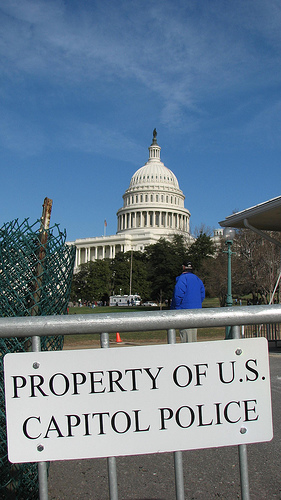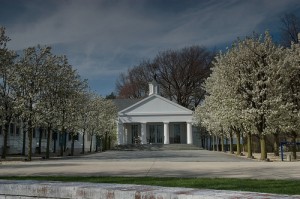April 21, 2011 | 9:03 AM | By Anna
Good morning, DCentric readers! Ready for some links?
The decline of the majority-black (Congressional) district, and what it means What black migrations mean for redistricting: ” (D.C.) saw its black population plummet 11 percent over the last decade, while suburban D.C. Rep. Steny Hoyer (D-Md.) gained more black voters than anyone outside of the fast-growing Atlanta area…The effect of all this movement is that the black population is significantly more dispersed than it was a decade ago…In other words, significant line changes will have to be made to keep these districts as heavily black as they were for the last decade.” At least those new Maryland residents have representation to go with their taxation. (The Washington Post)
The Black Class War of the Obama Critics “With 84 percent of African Americans supporting the President in a recent Gallup poll, the most public voices of dissent on Obama seem to come from some pretty lofty places — the halls of academia and out of the mouths of the educated, black “sophisticate.” The Intelligentsia. Also known as the Talented Tenthers — those who believe within their backgrounds and breeding is the salvation of the African American community.” (TheLoop21)
As the Economy Recovers, Mayor Gray’s proposed FY 2012 Budget Leaves Little Room for Affordable Housing “Despite the fact that rents in DC have risen faster than in most major cities — and faster than the incomes of most DC households — and that many families are still reeling in the wake of the Great Recession, Mayor Gray’s proposed budget would make significant reductions and changes to some of DC’s main affordable housing programs. The result would be to significantly weaken the District’s capacity to respond to the affordable housing needs of DC’s low- and moderate-income residents.” (dcfpi.org)
Continue reading →
April 20, 2011 | 3:45 PM | By Anna

Flickr: Jonathon D. Colman
Yesterday, over 50 African American employees began the process of filing a discrimination complaint against the Capitol Police, a federal police force tasked with protecting the United States Congress:
In a press conference, members of the U.S. Capitol Black Police Association announced they intended to file a classwide request for counseling with the Office of Compliance, which will “initiate a process that will in all likelihood lead to yet another discrimination complaint” filed against Capitol Police, according to association member and Capitol Police Lt. Frank Adams.
Cited as reasons for the action are reprisals, hostile work environment and discrimination committed against black employees by the Capitol Police, the Capitol Police Board and the senior employment counsel for both, Frederick Herrera.
“The United States Capitol Police Department continues to project a model culture of discrimination as reflected in a ‘modern day version of a 19th Century Southern Plantation in law enforcement,’” Adams said.
The U.S. Capitol Police did not immediately respond to a request for comment.
A decade ago, over 300 Capitol Police employees filed a class-action discrimination lawsuit which has yet to be resolved.
Captial Bikeshare is poised to expand by 25 stations and the District Department of Transportation released a map today showing potential sites for the expansion of the system.
The new stations will be picked out of a list of 55 possibilities, including five sites East of the River in Wards 7 and 8. Why so few proposed sites in such a large swath of the District?
Part of the reason seems to be the amount of density needed to support stations, as well as demand. It’s well documented that use is low East of the River and the demand in Downtown is quite high. We spoke with DDOT spokesman John Lisle a few weeks ago to get more thoughts on how the agency will pick where bike stations go, and he said there are definitely “competing interests” at hand.

DDOT
Few stations exist East of the Anacosita River (in red).
Continue reading →
This week’s Newsweek coverage story “Can Manhood Survive the Recession?” paints a grim picture for educated, white men:
Through the first quarter of 2011, nearly 600,000 college-educated white men ages 35 to 64 were unemployed, according to previously unpublished Labor Department stats. That’s more than 5 percent jobless—double the group’s pre-recession rate. That might not sound bad compared with the plight of younger, less-educated workers and minorities, but it’s a historic change from the last recession, when about half as many lost their oxford shirts. The number of college-educated men unemployed for at least a year is five times higher today than after the dotcom bubble.

Flickr: Wirawat Lian-udom
White men are faring better than most in this recession.
If the idea is to have a competition over who has it the worst, the numbers make it quite clear: that’s one contest white men aren’t going to win. According to the U.S. Department of Labor, the unemployment rate among whites was 8 percent in January — that’s almost half of what it was for blacks, 15.7 percent. Latinos didn’t fare well either with an unemployment rate of 11.9 percent.
Here in D.C., the unemployment rate citywide was 9.6 percent in January. In predominately black Wards 7 and 8, it ranged between 20 to 18 percent, and in predominately white Ward 3, it was 3.6 percent.
Continue reading →
April 20, 2011 | 8:58 AM | By Anna
Good morning, DCentric readers! On weekdays that end with “y”, we like to serve up links. Let’s get to it:
The Straight Dope – Bill Moyers interviews David Simon “The Wire”-creator David Simon on the drug war: “The people most affected by this are black and brown and poor. It’s the abandoned inner cores of our urban areas. As we said before, economically, we don’t need those people; the American economy doesn’t need them. So as long as they stay in their ghettos and they only kill each other, we’re willing to pay for a police presence to keep them out of our America. And to let them fight over scraps, which is what the drug war, effectively, is.” (Guernica)
Homeless Families: not a part of Mayor Gray’s “One City” “There are 858 homeless families in the District, including more than 1,600 children. This represents an astounding 46 percent increase in homeless families since 2008, or 271 new families. Stacked against these families is a FY 2012 budget proposal that would shrink the homeless services budget by up to a quarter and dramatically cuts other services needed to help these families back to their feet, including cash assistance and affordable housing.” (dcfpi.org)
Nonresidents get a pass on DCPS tuition Last month, a child who brought cocaine to Thomson Elementary was found to be a Marlyand, not D.C. resident: “”I am deeply concerned that District tax dollars are being spent on a significant number of students that are not eligible to attend our schools,” at-large D.C. Councilman Sekou Biddle told De’Shawn Wright, deputy mayor for education, in a letter. Wright agreed that the Student Residency Office was understaffed and that “challenges” include the collection of nonresident tuition. DCPS does not employ a collection agency.” (Washington Examiner )
Continue reading →

Flickr: Barjack
The tragic circumstances surrounding the April 7th shooting death of a popular H.D. Woodson High School student point to a challenge that many of D.C.’s kids face as they seek to have active, healthy lives.
Raheem Jackson, 16, was reportedly trying to buy a gun from someone who robbed and killed him instead. Washington Post columnist Courtland Milloy wrote that
… If true, he would not have been the first otherwise law-abiding youngster who felt the need to carry a firearm for protection.
A star basketball player at Woodson, he’d leave practice long after sundown and have anxious walks home in the dark. Many students have refused to participate in extracurricular school activities because it just isn’t safe to be out at night.
As noted by Homicide Watch D.C., Jackson had even written a poem about his scary walks home, which was published by his school newspaper The Insider:
Continue reading →
April 19, 2011 | 3:40 PM | By Anna

Flickr: Washington Area Bicyclist Association
Ken Archer published a thought-provoking post in Greater Greater Washington — “True urbanism must come with a big tent“– about how race intersects with smart growth:
Urbanism can and should command a broader constituency, including families, the elderly and the poor and working-class…Prominent amongst the benefits that flow from density plus proper planning and development are the freedom to participate in diverse communities of cultural depth and richness.
Kunstler, Duany and Jacobs bemoan the damage done to cultural institutions sustained by cities as a result of suburban sprawl. Yet urbanists in DC don’t bemoan the loss of communities and cultural memory when neighborhoods turnover their residents – it’s just the free market at work.
These same authors praise the generational and socioeconomic diversity that is possible in cities. Jacobs writes that “cities have the capability of providing something for everybody, only because, and only when, they are created by everybody.”
There’s a robust discussion occurring in the comments, as well.
April 19, 2011 | 9:01 AM | By Anna
Good morning, DCentric readers! Ready for some calorie-free links?
D.C. voting rights proponents’ faith in Obama sinks “Mark Plotkin, a WTOP political commentator who has made District statehood something of an obsession, said he sees little to distinguish Obama from his Republican predecessor, George W. Bush…“The greatest assault is indifference, and he has the hubris to take us for granted,” Plotkin said of Obama. “He went to Cairo to talk about democracy. He won’t go to Brentwood or Deanwood. He has not made one utterance about D.C. to D.C. in D.C.”” (The Washington Post)
Georgetown Flooding Hits Businesses Hard And it hits the suddenly out-of-work retail staff, bartenders and servers just as hard: “The tab for the Washington Harbor flooding could be in the millions, according to property managers familiar with the complex. That figure does not include lost wages for hundreds of workers…The biggest toll may be on the people who keep it all going. While many of these businesses are insured, the workers are not.” (WUSA Washington, DC)
How Donald Trump Lost the Black Vote “Plenty of black folks appreciate a blunt-talking guy dipped in expensive suits, as much as — if not more — than the next person. If Trump had coupled his reality-TV and Twitter-friendly style with the tolerant social views and “You can have all this, too” team-of-me ethos that he once touted, he could have been the one candidate in the 2012 Republican field to peel away a few black votes from Obama…But once Trump started arguing that Obama wasn’t American, whatever goodwill he had in blackworld up and vanished.” (The Root)
Continue reading →
April 18, 2011 | 12:57 PM | By Anna

Flickr: TopRow
Maumee Valley Country Day School, Michelle Rhee's alma mater.
The New York Times points out something important about the school reform movement– those involved, including former D.C. schools chief Michelle Rhee and President Barack Obama, did not attend public schools:
Those who call themselves reformers are a diverse group, men and women of every political stripe and of every race and ethnicity.
But there is one thing that characterizes a surprisingly large number of the people who are transforming public schools: they attended private schools.
Which raises the question: Does a private school background give them a much-needed distance and fresh perspective to better critique and remake traditional public schools? Does it make them distrust public schools — or even worse — poison their perception of them? Or does it make any difference?
April 18, 2011 | 8:53 AM | By Anna
Good morning, DCentric readers! Let’s kick off Tax Day with some links!
At Last, Kudos for Elizabeth Catlett Born and raised in Washington, D.C., Catlett was the granddaughter of slaves. Said Kinshasha Holman Conwill of the Smithsonian’s National Museum of African American History and Culture: “For over six decades she has created unforgettable art that serves as eloquent testimony to the struggles of African Americans, especially women. Whether in works finely wrought in wood and bronze or in her elegiac works on paper, she has given us images of singular power and beauty.” (The Root)
‘Arrest’ raises Vincent Gray’s street cred Gray may not have had an easy first 100 days in office, but someone in D.C. is having the Best Week Ever! After getting arrested and drawing attention to the ways our city has been slighted, “Mr. Gray reclaimed the momentum that had propelled him to office by a decisive margin and arguably had his best week as D.C.mayor.” (Washington Times)
For richest, federal taxes have gone down; for some in U.S., they’re nonexistent This seems appropriate, today: “More than half of the nation’s tax revenue came from the top 10 percent of earners in 2007. More than 44 percent came from the top 5 percent. Still, the wealthy have access to much more lucrative tax breaks than people with lower incomes. Obama wants the wealthy to pay so “the amount of taxes you pay isn’t determined by what kind of accountant you can afford.” (The Washington Post)
Continue reading →








